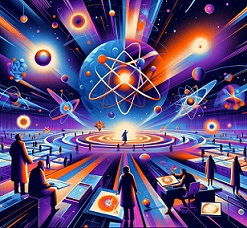The ALICE Collaboration proposes a completely new apparatus, ALICE 3, for the LHC Runs 5 and 6 (arXiv:2211.02491). The detector consists of a large pixel-based tracking system covering eight units of pseudorapidity, complemented by multiple systems for particle identification, including silicon time-of-flight layers, a ring-imaging Cherenkov detector, a muon identification system, and an...
We analyze the modifications that a dense nuclear medium induces in the Ds(2317)± and Tcc(3875)±. In the vacuum, we consider them as isoscalar DK (Dbar Kbar) and DD (Dbar Dbar) S-wave bound states, which are dynamically generated from effective interactions that lead to different Weinberg compositeness scenarios. Matter effects are incorporated through the two-meson loop functions, taking into...
In this talk, I will present our extensions of MadGraph5_aMC@NLO for two
asymmetric systems, photoproduction and proton-nucleus collisions, as well as progress towards automation of computations for inclusive-quarkonium production, currently being worked out at leading order.
Indeed, to consolidate the figures of merit of a variety of measurements at the Electron-Ion Collider and systematise...
LaVA is established within the STRONG-2020 project, with the support of FBK/ECT* and INFN, with the aim of providing an advanced and inclusive tool for training in Lattice Field Theory. The scientific management is done by the LatticeHadrons Network of Strong-2020 , with the support of an invited Advisory Board comprising leading scientists in the field.
A Beta version of the site is...
The INFN Laboratories of Frascati (LNF) are a very sparkling laboratory.
Thanks to already existing and planned high-quality infrastructures, they
represent an ideal environment to perform Hadron Physics experiments.
The main infrastructure is the DAFNE e+e- collider, where several crucial
activities and experiments have been already performed in the strangeness
sector. In particular, the...
Two of the major scientific drivers of particle physics and cosmology are the faith of antimatter after the Big Bang and the origin of Dark Matter. The answers to these questions can be addressed by investigating permanent and oscillating Electric Dipole Moments (EDM) of fundamental particles. The experiments can be performed with polarized beams in a dedicated storage ring.
Important...
In this talk I will review the recent developments on strangeness hadron physics, covering aspects of the elementary interactions of kaons and hyperons with nucleons and nuclei. I will also discuss the impact of strange particles in astrophysical contexts, analyzing their role in the properties of neutron stars and in the characteristics of gravitational waves produced during binary neutron...
The HERMES experiment has collected a wealth of data using the 27.6 GeV longitudinally polarized HERA lepton beam and various polarized and unpolarized gaseous targets. This allows for a series of unique measurements of observables sensitive to the multidimensional (spin) structure of the nucleon, in particular semi-inclusive deep-inelastic scattering (SIDIS) measurements, for which the HERMES...
Phenomenological evidence suggests that strong decays of low-excitation hadrons often involve the creation of a light quark-antiquark pair with zero angular momentum, known as the $^3P_0$ mechanism, derived from a scalar bilinear. Despite Quantum Chromodynamics being mediated perturbatively by spin-one gluons and exhibiting chiral symmetry in its Lagrangian, a scalar decay term appears...
The discovery of the X, Y, Z states in the (hidden) charm meson sector first by Belle, and the P_C baryon states by LHCb revealed the existence of multi-quark objects beyond the simple quark-antiquark or 3-quark valence configurations. If the emergence of such multi-quark structures was a general feature of QCD, then related structures should exhibit in the uds-sector as well. The BGOOD...

